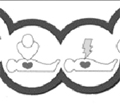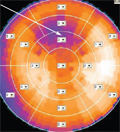The eLitMed.hu medical portal uses computer cookies for convenient operation. Detailed information can be found in the Cookie-policy.
Lege Artis Medicinae - 2005;15(05)
Content
[CURRENT PRACTICE AND PROBLEMS IN RESUSCITATION]
[Cardiopulmonary resuscitation is the progressive management of sudden cardiac arrest with the goal of restoring spontaneous circulation and preserve vital organ functions. Sudden cardiac death occuring out of hospital is still one of the major causes of death among otherwise healthy and young population however, approppriate management - certainly including resuscitation as the first step - might provide a reasonably good quality of life. Long term outcome of resuscitation is mainly determined by the links of the Chain of Survival, eg. early access, early CPR, early defibrillation and early advanced care. The aim of this review is to present the upto- date concepts for the best management of these survival links.]
[SUBSTANCE ABUSE AND CARDIOVASCULAR SYSTEM]
[Substance abuse is an immense problem in Hungary and around the world. Psychological effects of this condition are widely known for abusers and health care workers. Cardiovascular effects of illicit substances are much less well known and can develop as very severe diseases (myocardial infarction, extremely high blood pressure, intracerebral haemorrhage, sudden death etc.) and occur particularly in young people. The treatment of cardiovascular complications of substance abuse may differ from that accepted in non-abusers and some drugs (for example: β-blockers) may be contraindicated. In this review, the effects of substance abuse on the cardiovascular system are discussed, including effects of most commonly abused substances: cocaine, amphetamines, heroin, LSD, marijuana, inhalative substances. In this review the cardiovascular effects of sedato-hypnotics and most widely used substances (alcohol, nicotine, caffeine) are not adressed, since they are well known.]
[NEUTROPENIA AND SUBSEQUENT INFECTION IN HEMATOLOGICAL DISEASES]
[Neutropenia is an immunocompromised state commonly occurring in hematological practice. The underlying disorder responsible for a critical drop in absolute granulocyte count can either be of congenital or acquired nature. Neutropenic patients frequently develop serious, at times even fatal infections. Severity of illness, outcome, type of infecting organisms are markedly influenced by additional risk factors such as impaired T- or B-lymphocyte function as well as the injury of biological barriers. Neutropenic infections should generally be treated according to evidence-based guidelines. However, in certain groups of patients, where randomized trials are lacking, all identified components of immunodeficiency should be taken into account and antimicrobial treatment or prophylaxis should individually be tailored.]
[THE ROLE OF REGISTRY ANALYSIS IN THE FORMING OF THERAPEUTIC GUIDELINES IN RENAL TRANSPLANTATION]
[The authors assess the two main outcomes of the immunosuppressive therapy after renal transplantation: graft and patient survival. According to their view, evidence from randomised clinical trials results can be well complemented by the several unique transplant registries and outcome research based upon these databases. The comparison of evidence from these two sources addresses the question of achievable outcome under ideal (controlled) versus real life conditions. Based on a systematic review of the relevant clinical trials and registries it can be stated, that in the case of some immunosuppressants (mycophenolate mofetil vs azathioprine, microemulsified cyclosporin vs cyclosporin and tacrolimus vs cyclosporin) the improvement in the intermediate outcome can lead to improved graft and patient survival, while in the case of other drugs no significant difference in hard endpoints were detected (tacrolimus vs microemulsified cyclosporin). Evidence on graft and patient survival differences could not be derived from traditional randomised clinical trials, only from transplant registries. For the sake of improved evidence based therapeutic guidelines in renal transplantation, authors call for further development of the Hungarian transplant registry.]
[ISOTOPE BASED CARDIAC DIAGNOSTICS - POSSIBILITIES IN NUCLEAR CARDIOLOGY]
[Methods of nuclear cardiology have been applied for several decades and there is continuous development in this area. The most commonly used modality is the myocardial perfusion scintigraphy (MPS). During stress MPS, the presence and the severity of ischaemic heart disease (IHD) can be detected. Resting MPS can show a freshly developing acut myocardial infarction (AMI) immediately, but new and old infarcted myocardial areas can not be distinguished by this method. Using SPECT (single photon emission tomography) examination and quantitative analysis can improve the accuracy of MPS. With gated SPECT we can analyse both the perfusion and the function of left ventricle. To examine the function of left and right ventricle the “gold standard” non-invasive method is MUGA (multiple gated acquisition) of blood pool scintigraphy. After only a few hours of the onset of AMI we can detect it with the socalled infarct avid scintigraphy using radiopharmaceuticals which accumulate in affected area. Following an AMI it is essential to differentiate among high and low risk patients for revascularisation treatment, therefore distinguishing the viable (hibernating) and non-viable (necrotic) myocardium with imaging techniques is an important task. Preserved metabolism as the sign of viable myocardium can be detected both by SPECT (most accurately by thallium rest-redistribution scintigraphy) and PET (detecting glucose metabolism by F-18-FDG). Adrenerg receptor scintigraphy can show the sympathetic innervation: in the case of a transplanted heart it can detect the reinnervation and in the case of malignant ventricular tachyarrhythmias the risks and the severity of the illness.]
1.
Clinical Neuroscience
[Headache registry in Szeged: Experiences regarding to migraine patients]2.
Clinical Neuroscience
[The new target population of stroke awareness campaign: Kindergarten students ]3.
Clinical Neuroscience
Is there any difference in mortality rates of atrial fibrillation detected before or after ischemic stroke?4.
Clinical Neuroscience
Factors influencing the level of stigma in Parkinson’s disease in western Turkey5.
Clinical Neuroscience
[The effects of demographic and clinical factors on the severity of poststroke aphasia]1.
2.
Clinical Oncology
[Pancreatic cancer: ESMO Clinical Practice Guideline for diagnosis, treatment and follow-up]3.
Clinical Oncology
[Pharmacovigilance landscape – Lessons from the past and opportunities for future]4.
5.











